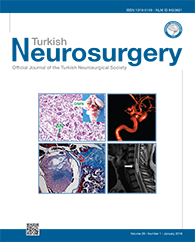2Yonghe Cardinal Tien Hospital, Department of Neurosurgery, New Taipei City, Taiwan
3Shin Kong Wu-Ho-Su Memorial Hospital, Department of Neurosurgery, Taipei, Taiwan
4Taipei Veterans General Hospital, Department of Emergency Medicine, Taipei, Taiwan
5Fu-Jen Catholic University, School of Medicine, New Taipei City, Taiwan
6Cathay General Hospital, Department of Surgery, Division of Neurosurgery, Taipei, Taiwan DOI : 10.5137/1019-5149.JTN.18752-16.1 AIM: Shunt-dependent hydrocephalus (SDH) is a relatively common complication following aneurysmal subarachnoid hemorrhage (aSAH). Delay in diagnosis and treatment may worsen neurological outcome. This study was conducted to identify early clinical factors associated with SDH following aSAH.
MATERIAL and METHODS: Patients diagnosed with aSAH at our hospital from January 2010 through July 2014 were included. Patients aged ? 18 or ? 90 years, with concurrent arteriovenous malformation, treated with both clipping and coiling, or not receiving definitive treatment were excluded. Both clinical and radiological variables were analyzed by univariate and multivariate logistic model to identify factors independently associated with outcome of SDH following aSAH.
RESULTS: Overall, 33 patients (36.2%) developed SDH following aSAH after definitive treatment. Univariate analysis revealed
age, emergency department (ED) white blood cell (WBC) count, hypernatremia, Hunt & Hess Grade, modified Fisher"s Grade,
presentation of acute hydrocephalus, initial placement of external ventriculostomy, and post-operative central nervous system
infection were clinically significant factors. Multivariate logistic regression showed ED WBC count >14,500/?L (OR 5.096, 95% CI
1.332 to 19.499, p=0.017), poor Hunt&Hess Grade (III, IV & V) (OR 3.562, 95% CI 1.081 to 11.737, p=0.037), and initial placement
of external ventriculostomy (OR 4.294, 95% CI 1.125 to 16.393, p=0.033) were independent factors.





